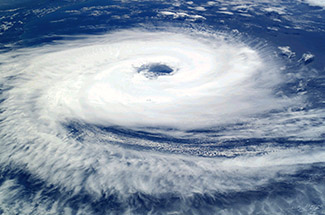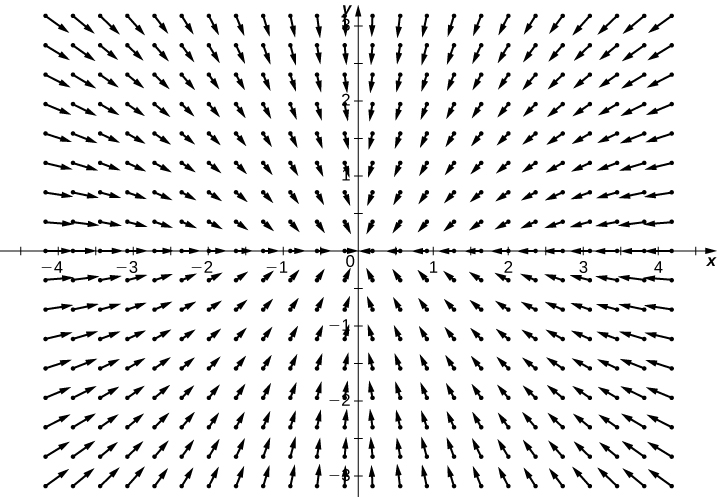Learning Objectives
- Recognize a vector field in a plane or in space.
- Sketch a vector field from a given equation.
Examples of Vector Fields
How can we model the gravitational force exerted by multiple astronomical objects? How can we model the velocity of water particles on the surface of a river? Figure 1 gives visual representations of such phenomena.
Figure 1(a) shows a gravitational field exerted by two astronomical objects, such as a star and a planet or a planet and a moon. At any point in the figure, the vector associated with a point gives the net gravitational force exerted by the two objects on an object of unit mass. The vectors of largest magnitude in the figure are the vectors closest to the larger object. The larger object has greater mass, so it exerts a gravitational force of greater magnitude than the smaller object.
Figure 1(b) shows the velocity of a river at points on its surface. The vector associated with a given point on the river’s surface gives the velocity of the water at that point. Since the vectors to the left of the figure are small in magnitude, the water is flowing slowly on that part of the surface. As the water moves from left to right, it encounters some rapids around a rock. The speed of the water increases, and a whirlpool occurs in part of the rapids.

Figure 1. (a) The gravitational field exerted by two astronomical bodies on a small object. (b) The vector velocity field of water on the surface of a river shows the varied speeds of water. Red indicates that the magnitude of the vector is greater, so the water flows more quickly; blue indicates a lesser magnitude and a slower speed of water flow.
Each figure illustrates an example of a vector field. Intuitively, a vector field is a map of vectors. In this section, we study vector fields in [latex]\mathbb{R}^2[/latex] and [latex]\mathbb{R}^3[/latex].
definition
A vector field [latex]F[/latex] in [latex]\mathbb{R}^2[/latex] is an assignment of a two-dimensional vector [latex]{\bf{F}}(x,y)[/latex] to each point [latex](x, y)[/latex] of a subset [latex]D[/latex] of [latex]\mathbb{R}^2[/latex]. The subset [latex]D[/latex] is the domain of the vector field.
A vector field [latex]F[/latex] in [latex]\mathbb{R}^3[/latex] is an assignment of a three-dimensional vector [latex]{\bf{F}}(x,y,z)[/latex] to each point [latex](x, y, z)[/latex] of a subset [latex]D[/latex] of [latex]\mathbb{R}^3[/latex]. The subset [latex]D[/latex] is the domain of the vector field.
Vector Fields in [latex]\mathbb{R}^2[/latex]
A vector field in [latex]\mathbb{R}^2[/latex] can be represented in either of two equivalent ways. The first way is to use a vector with components that are two-variable functions:
[latex]\large{{\bf{F}}(x,y)=\langle{P}(x,y),Q(x,y)\rangle}[/latex].
The second way is to use the standard unit vectors:
[latex]\large{{\bf{F}}(x,y)=P(x,y){\bf{i}}+Q(x,y){\bf{j}}}[/latex].
A vector field is said to be continuous if its component functions are continuous.
Example: finding a vector associated with a given point
Let [latex]{\bf{F}}(x,y)=(2y^2+x-4){\bf{i}}+\cos(x){\bf{j}}[/latex] be a vector field in [latex]\mathbb{R}^2[/latex]. Note that this is an example of a continuous vector field since both component functions are continuous. What vector is associated with point [latex](0, -1)[/latex]?
try it
Let [latex]{\bf{G}}(x,y)=x^2y{\bf{i}}-(x+y){\bf{j}}[/latex] be a vector field in [latex]\mathbb{R}^2[/latex]. What vector is associated with the point [latex](-2, 3)[/latex]?
Drawing a Vector Field
We can now represent a vector field in terms of its components of functions or unit vectors, but representing it visually by sketching it is more complex because the domain of a vector field is in [latex]\mathbb{R}^2[/latex], as is the range. Therefore the “graph” of a vector field in [latex]\mathbb{R}^2[/latex] lives in four-dimensional space. Since we cannot represent four-dimensional space visually, we instead draw vector fields in [latex]\mathbb{R}^2[/latex] in a plane itself. To do this, draw the vector associated with a given point at the point in a plane. For example, suppose the vector associated with point [latex](4, -1)[/latex] is [latex]\langle3,1\rangle[/latex]. Then, we would draw vector [latex]\langle3,1\rangle[/latex] at point [latex](4,-1)[/latex].
We should plot enough vectors to see the general shape, but not so many that the sketch becomes a jumbled mess. If we were to plot the image vector at each point in the region, it would fill the region completely and is useless. Instead, we can choose points at the intersections of grid lines and plot a sample of several vectors from each quadrant of a rectangular coordinate system in [latex]\mathbb{R}^2[/latex].
There are two types of vector fields in [latex]\mathbb{R}^2[/latex] on which this chapter focuses: radial fields and rotational fields. Radial fields model certain gravitational fields and energy source fields and rotational fields model the movement of a fluid in a vortex. In a radial field, all vectors either point directly toward or directly away from the origin. Furthermore, the magnitude of any vector depends only on its distance from the origin. In a radial field, the vector located at point [latex](x, y)[/latex] is perpendicular to the circle centered at the origin that contains point [latex](x, y)[/latex], and all other vectors on this circle have the same magnitude.
Example: drawing a radial vector field
Sketch the vector field [latex]{\bf{F}}(x,y)=\frac{x}2{\bf{i}}+\frac{y}2{\bf{j}}[/latex].
try it
Draw the radial field [latex]\small{{\bf{F}}(x,y)=-\frac{x}3{\bf{i}}-\frac{y}3{\bf{j}}}[/latex].
In contrast to radial fields, in a rotational field, the vector at point [latex](x, y)[/latex] is tangent (not perpendicular) to a circle with radius [latex]r=\sqrt{x^2+y^2}[/latex]. In a standard rotational field, all vectors point either in a clockwise direction or in a counterclockwise direction, and the magnitude of a vector depends only on its distance from the origin. Both of the following examples are clockwise rotational fields, and we see from their visual representations that the vectors appear to rotate around the origin.
Example: chapter opener: drawing a Rotational vector field

Figure 4. (credit: modification of work by NASA)
Sketch the vector field [latex]{\bf{F}}(x,y)=\langle{y},-x\rangle[/latex].
Example: sketching a vector field
Sketch vector field [latex]{\bf{F}}(x,y)=\frac{y}{x^2+y^2}{\bf{i}}-\frac{x}{x^2+y^2}{\bf{j}}[/latex].
try it
Sketch vector field [latex]{\bf{F}}(x,y)=\langle-2y,2x\rangle[/latex]. Is the vector field radial, rotational, or neither?
Example: velocity field of a fluid
Suppose that [latex]{\bf{v}}(x,y)=-\frac{2y}{x^2+y^2}{\bf{i}}+\frac{2x}{x^2+y^2}{\bf{j}}[/latex] is the velocity field of a fluid. How fast is the fluid moving at point [latex](1, -1)[/latex]? (Assume the units of speed are meters per second.)
try it
Vector field [latex]v(x,y)=\langle4|x|,1\rangle[/latex] models the velocity of water on the surface of a river. What is the speed of the water at point [latex](2, 3)[/latex]? Use meters per second as the units.
Watch the following video to see the worked solution to the above Try It
We have examined vector fields that contain vectors of various magnitudes, but just as we have unit vectors, we can also have a unit vector field. A vector field [latex]\bf{F}[/latex] is a unit vector field if the magnitude of each vector in the field is [latex]1[/latex]. In a unit vector field, the only relevant information is the direction of each vector.
Example: a unit vector field
Show that vector field [latex]{\bf{F}}(x,y)=\left\langle\frac{y}{\sqrt{x^2+y^2}},-\frac{x}{\sqrt{x^2+y^2}}\right\rangle[/latex] is a unit vector field.
try it
Is vector field [latex]{\bf{F}}(x,y)=\langle-y,x\rangle[/latex] a unit vector field?
Why are unit vector fields important? Suppose we are studying the flow of a fluid, and we care only about the direction in which the fluid is flowing at a given point. In this case, the speed of the fluid (which is the magnitude of the corresponding velocity vector) is irrelevant, because all we care about is the direction of each vector. Therefore, the unit vector field associated with velocity is the field we would study.
If [latex]{\bf{F}}(x,y)=\langle{P,Q,R}\rangle[/latex] is a vector field, then the corresponding unit vector field is [latex]\left\langle\frac{P}{||{\bf{F}}||},\frac{Q}{||{\bf{F}}||},\frac{R}{||{\bf{F}}||}\right\rangle[/latex]. Notice that if [latex]{\bf{F}}(x,y)=\langle{y},-x\rangle[/latex] is the vector field from Example “Chapter Opener: Drawing a Rotational Vector Field”, then the magnitude of [latex]\bf{F}[/latex] is [latex]\sqrt{x^2+y^2}[/latex], and therefore the corresponding unit vector field is the field [latex]\bf{G}[/latex] from the previous example.
If [latex]\bf{F}[/latex] is a vector field, then the process of dividing [latex]\bf{F}[/latex] by its magnitude to form unit vector field [latex]{\bf{F}}/||{\bf{F}}||[/latex] is called normalizing the field [latex]\bf{F}[/latex].
Vector Fields in [latex]\mathbb{R}^3[/latex]
We have seen several examples of vector fields in [latex]\mathbb{R}^2[/latex]; let’s now turn our attention to vector fields in [latex]\mathbb{R}^3[/latex]. These vector fields can be used to model gravitational or electromagnetic fields, and they can also be used to model fluid flow or heat flow in three dimensions. A two-dimensional vector field can really only model the movement of water on a two-dimensional slice of a river (such as the river’s surface). Since a river flows through three spatial dimensions, to model the flow of the entire depth of the river, we need a vector field in three dimensions.
The extra dimension of a three-dimensional field can make vector fields in [latex]\mathbb{R}^3[/latex] more difficult to visualize, but the idea is the same. To visualize a vector field in [latex]\mathbb{R}^3[/latex], plot enough vectors to show the overall shape. We can use a similar method to visualizing a vector field in [latex]\mathbb{R}^2[/latex] by choosing points in each octant.
Just as with vector fields in [latex]\mathbb{R}^2[/latex], we can represent vector fields in [latex]\mathbb{R}^3[/latex] with component functions. We simply need an extra component function for the extra dimension. We write either
[latex]\large{{\bf{F}}(x,y,z)=\langle{P}(x,y,z),Q(x,y,z),R(x,y,z)\rangle}[/latex]
or
[latex]\large{{\bf{F}}(x,y,z)=P(x,y,z){\bf{i}}+Q(x,y,z){\bf{j}}+R(x,y,z){\bf{k}}}[/latex].
Example: sketching a vector field in three dimensions
Describe vector field [latex]{\bf{F}}(x,y,z)=\langle1,1,z\rangle[/latex].
try it
Sketch vector field [latex]{\bf{G}}(x,y,z)=\langle2,\frac{z}2,1\rangle[/latex].
In the next example, we explore one of the classic cases of a three-dimensional vector field: a gravitational field.
Example: Describing a gravitational vector field
Newton’s law of gravitation states that [latex]{\bf{F}}=-G\frac{m_1m_2}{r^2}{\bf{\hat{r}}}[/latex], where [latex]G[/latex] is the universal gravitational constant. It describes the gravitational field exerted by an object (object 1) of mass [latex]m_1[/latex] located at the origin on another object (object 2) of mass [latex]m_2[/latex] located at point [latex](x, y, z)[/latex]. Field [latex]{\bf{F}}[/latex] denotes the gravitational force that object 1 exerts on object 2, [latex]r[/latex] is the distance between the two objects, and [latex]{\bf{\hat{r}}}[/latex] indicates the unit vector from the first object to the second. The minus sign shows that the gravitational force attracts toward the origin; that is, the force of object 1 is attractive. Sketch the vector field associated with this equation.
try it
The mass of asteroid 1 is [latex]750,000[/latex] kg and the mass of asteroid 2 is [latex]130,000[/latex] kg. Assume asteroid 1 is located at the origin, and asteroid 2 is located at [latex](15, -5, 10)[/latex], measured in units of 10 to the eighth power kilometers. Given that the universal gravitational constant is [latex]G=6.67384\times10^{-11}\text{m}^3\text{kg}^{-1}\text{s}^{-2}[/latex], find the gravitational force vector that asteroid 1 exerts on asteroid 2.
Watch the following video to see the worked solution to the above Try It
Candela Citations
- CP 6.4. Authored by: Ryan Melton. License: CC BY: Attribution
- CP 6.7. Authored by: Ryan Melton. License: CC BY: Attribution
- Calculus Volume 3. Authored by: Gilbert Strang, Edwin (Jed) Herman. Provided by: OpenStax. Located at: https://openstax.org/books/calculus-volume-3/pages/1-introduction. License: CC BY-NC-SA: Attribution-NonCommercial-ShareAlike. License Terms: Access for free at https://openstax.org/books/calculus-volume-3/pages/1-introduction








